MARIANI’S
Virtual Gourmet
December 28,
2014
NEWSLETTER
HOME | BOOKS | CONTACT
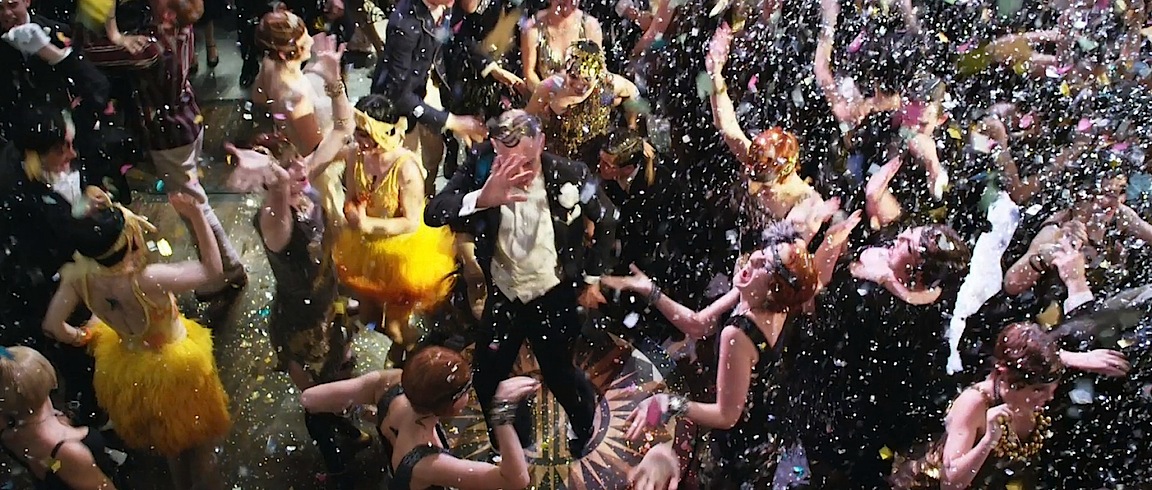
HAPPY NEW YEAR!
❖❖❖
IN THIS ISSUE
DINING OUT IN ATLANTA
By John Mariani
NEW YORK CORNER
BURKE & WILLS
By John Mariani
❖❖❖
OUT AND ABOUT IN ATLANTA
By John Mariani

As the South's major
hub city, Atlanta’s restaurateurs are in fierce
competition among restaurateurs seeking to attract
locals, tourists, and both national and
international business. So for more than two
decades, the city has been home to every kind of
ethnic eatery, plenty of steakhouses, and a
ballast of places that are part of Southern
culinary tradition.
Here are some of the new ones I like.
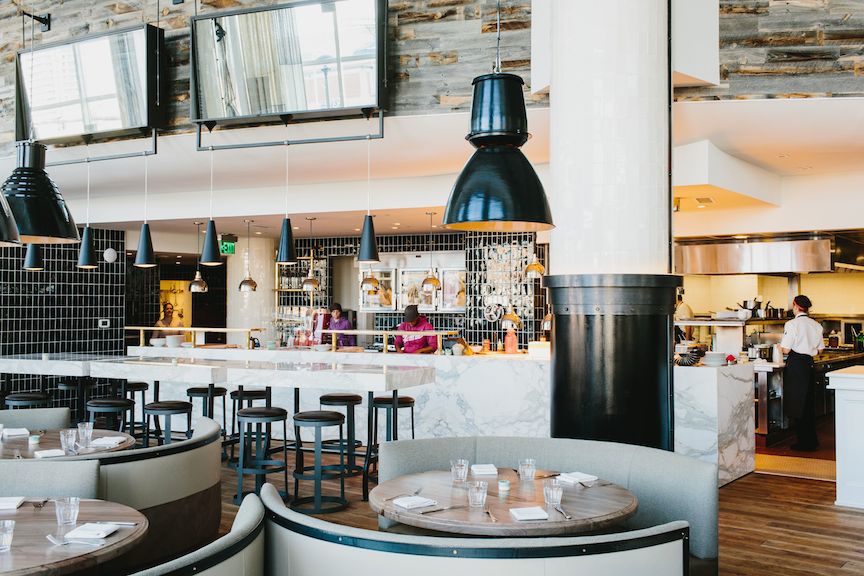 St.
Cecilia
St.
Cecilia
3455 Peachtree Road NE
404-554-0005
stceciliaatl.com
Chef-restaurateur Ford Fry may
have developed into Atlanta’s golden boy, having
opened the bellwether seafood restaurant The
Optimist, then the meat-centric King & Duke—he
was also Justin Bieber’s personal chef for three
months this year--and now an Italian seafood
restaurant named, for no particular reason after
Saint Cecilia, patroness of musicians. All this in
the last three years. That’s a lot of activity for a
corporate chef (he also owns the Southern-style
JCT.Kitchen and a place in nearby Decatur and is
about to open a Mexican restaurant, too), so I
wonder if all his enterprises have maintained their
original quality.
When I visited St. Cecilia, it was pretty
new, and the kitchen and service staff were clearly
stretched and stressed. This used to be another
wonderful seafood place named Bluepointe, and the
bones of the soaring building are still there, with
vast amounts of glass, hanging lamps, subway tiles,
and wood, but nothing at all to tamp down the
achingly loud noise level. 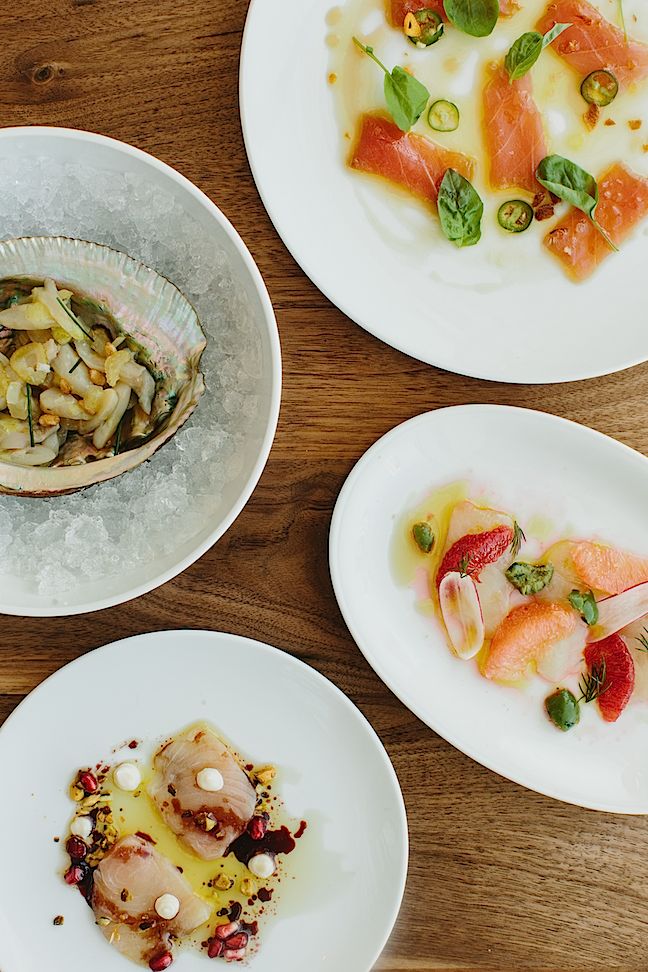
The
room is huge and so is the menu—far too large to
allow the kitchen to serve hundreds of guests beyond
a “get-‘er-done” efficiency. Odd, then, the menu
reports that it “changes daily,” meaning little or
no time to perfect a dish. No surprise, then, that
the crudo (right)
seafood dishes ($11-$18) are the
best way to go at the beginning because they need
only slicing and seasoning rather than long, careful
cooking time . So, too, the excellent salumi
offerings ($14-$19) of meats and terrines.
Oversaucing and elaborating
most of the eight pasta selections work against
them. With the exception of a delicious agnolotti
filled with braised short ribs and dusted with
Parmigiano ($12), the rest I tried fell flat,
including caramelle
with smoked eggplant, tomato sauce, salsa verde and
ricotta
salata ($12) and corn-filled ravioli with
polenta, lobster and mascarpone ($14). Only a
chef unfamiliar with Italian pasta-making would
marry polenta on a plate with ravioli, which in the
South would be like putting grits on top of
mac-and-cheese.
Risotto ($15) with clams, always difficult to
get to the right texture, was overcooked that
evening.
As at The Optimist, the main seafood courses
ring truest: a wonderful porgy with grilled lettuce,
cucumber and capers ($47) and a whole loup de
mer with Marcona almonds and acidic citrus
($29) were impeccably cooked. 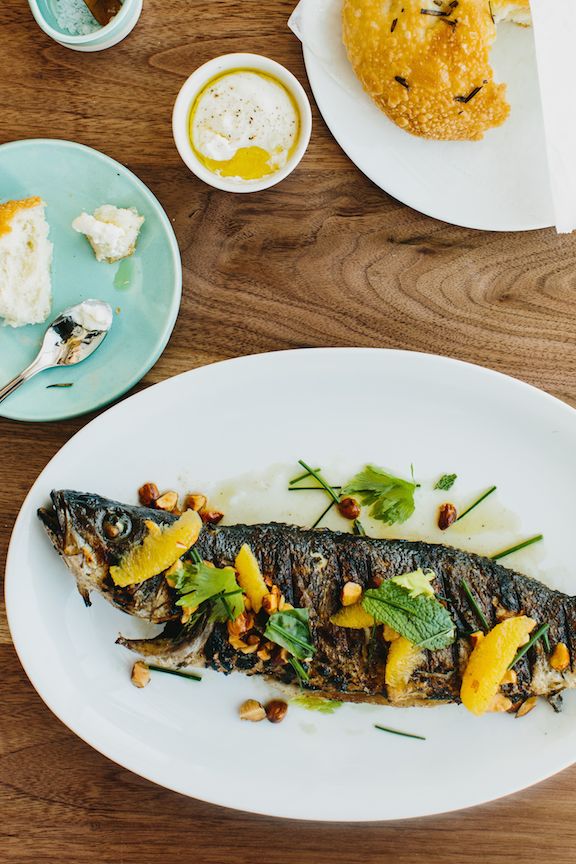 Swordfish was
well rendered, simply combined with olives, tomato
and garlic.
Swordfish was
well rendered, simply combined with olives, tomato
and garlic.
Clearly roast chicken dish and a strip steak
are on the menu solely to please non-seafood eaters,
and they taste that way. The chicken ($18) was not
juicy but watery, perhaps from over-brining.
Desserts (all $8) need tweaking: I liked dark
chocolate mousse ($8) and a crème brûlée tart, but
raspberry crèmeux, chocolate budino
and coconut milk
panna cotta were bland, as if prepared in
large batches to serve so many people.
It might be time for Fry and his group to slow down,
collect their thoughts, make everything work
smoothly, and focus in on their strength, which is
clearly fine seafood. And think about some sound
control.
St. Cecilia is open for lunch Mon.-Fri., dinner
nightly.
Ink and Elm
1577 N
Decatur Road
678-244-7050
inkandelmatlanta.com
Located in the Emory University area
of Druid Hills, Ink
and Elm was opened by Nick
Chaivarlis, Hunter Jefferson, and Keith Osborne a bit over a
year ago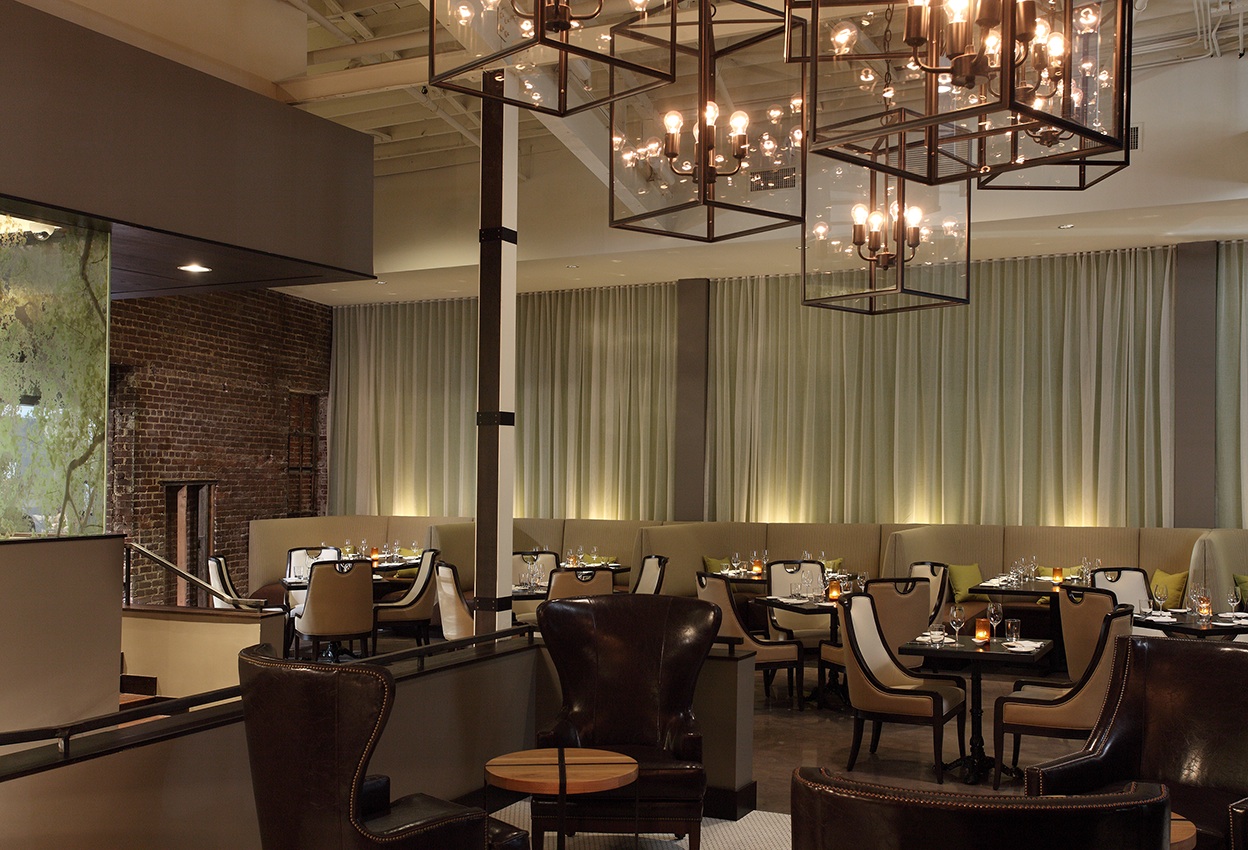 and named to
honor the neighborhood’s designer Frederick
Law Olmsted. Ink & Elm: According
to the restaurant website, “`Ink’ is an allusion to
Olmsted's renderings, while `Elm’ refers to his
“favorite type of tree. . . used to adorn the
streets of Druid Hills in the 1890s.”
and named to
honor the neighborhood’s designer Frederick
Law Olmsted. Ink & Elm: According
to the restaurant website, “`Ink’ is an allusion to
Olmsted's renderings, while `Elm’ refers to his
“favorite type of tree. . . used to adorn the
streets of Druid Hills in the 1890s.”
Inside there are three ways to dine in the cavernous
7,300 square foot space--in the Tavern, Dining Room,
or Lounge. The
first serves cocktails and sandwiches, the last
oysters and charcuterie plates. The
dining room is large, the tables commodious, and the
chandelier lighting and colors throughout make the
room darker than it looks in the photo to the right.
This includes dark wooden tables without tablecloths
that would reflect light and dampen sound, which is
absorbed only by tweed banquettes and a curtain of
sheer fabric. There’s
a truly lovely window on the kitchen overlaid with a
photograph of elm
trees in the local Lullwater Preserve.
Executive Chef Stephen Sharp has a fine flair for
modern American fare, putting emphasis on Southern
ingredients and seasonality. And he
keeps prices in reasonable line, perhaps so that
those Emory profs can dine here occasionally.
The
food has heft, it’s hearty, and it’s often deeply
flavorful, dependent on the high quality of
ingredients. Still, the dishes can be overloaded and
messy. Heirloom
tomato with pickled okra, Vidalia onion, cucumbers,
lady peas, herbs and soft boiled egg and dilly
vinaigrette ($14)
was all about summer. Veal sweetbreads ($14) came
with a sweet date puree and spinach adds a foil,
with pine nut pistou,
feta cheese, Port
pear and naan
Indian bread—way too much to allow the delicate
flavor of the sweetbreads to shine through. The
best dish I tried was a generous appetizer plate of
luscious, succulent Georgia shrimp (below) with
toasted butter, smoked ham broth, pickled peppers
and charred bread ($14), which I would gladly gobble
up as a main course. Pole beans and burrata
came with peaches, spiced pecans, sunburst tomato,
zucchini puree and shallot vinaigrette ($13); again,
the cream-centered cheese got lost in the rest of
the ingredients.
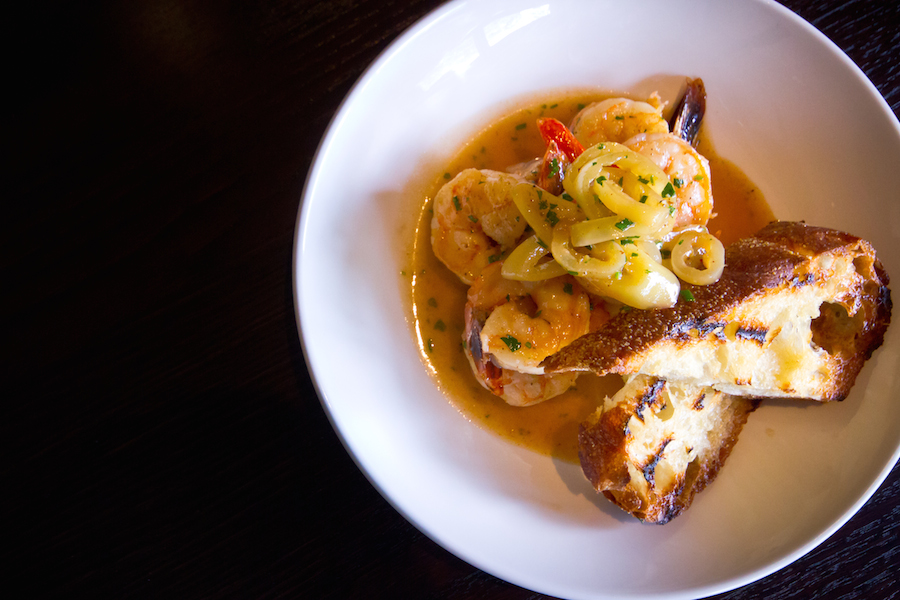 Entrees
include a beautifully cooked and well presented
trout with rock shrimp, carrot salsa verde, baby
carrots and a fennel confit ($35), which just
skirted being too many flavors on one plate. Carolina
pork with smoked belly, ham steak, garlic sausage,
field pea succotash, pole beans, leeks and a pork
demi-glace ($27) is more than enough food for two
people and speaks mightily of how good Southern
cooking can be.
So, too,
does the grouper with eggplant, okra, squash,
preserved tomato, purple peppers, corn and celery
($28), though few traditional Southern chefs would
ever pile so much on a fish. Another
big-hearted dish is the duo of lamb ($34)—braised
shank, crȇpinette,
smoked peach, harissa
for bite, bulgur, pickled cucumber, fava beans, and
almond gremolata.
Obviously, with these kinds of main items you
don’t need any side dishes.
Entrees
include a beautifully cooked and well presented
trout with rock shrimp, carrot salsa verde, baby
carrots and a fennel confit ($35), which just
skirted being too many flavors on one plate. Carolina
pork with smoked belly, ham steak, garlic sausage,
field pea succotash, pole beans, leeks and a pork
demi-glace ($27) is more than enough food for two
people and speaks mightily of how good Southern
cooking can be.
So, too,
does the grouper with eggplant, okra, squash,
preserved tomato, purple peppers, corn and celery
($28), though few traditional Southern chefs would
ever pile so much on a fish. Another
big-hearted dish is the duo of lamb ($34)—braised
shank, crȇpinette,
smoked peach, harissa
for bite, bulgur, pickled cucumber, fava beans, and
almond gremolata.
Obviously, with these kinds of main items you
don’t need any side dishes.
You may also be too stuffed for desserts, and they
are not lightweights. But they’re terrific, not
least the sticky cinnamon bun with pecans, sorghum,
bourbon glaze and welcome white cheddar ($9) and the
butterscotch pot de crème with pumpkin butter,
chocolate gingersnap and whipped cream ($9).
My eyes are now a
bit blurry and fingers sore just from typing out
those myriad ingredients dispersed with too much
unbridled enthusiasm
and little discrimination as to whether they
all go together.
Simplifying the menus and clashing flavors
would make Ink and Elm a much better restaurant than
it already is.
Open
Tues.-Sun. for dinner. Sunday for brunch.
Gio’s Chicken Amalfitano
and Antico Pizza
1099 Hemphill Avenue
404-347-3874
littleitalia.com
The Gio in
question is an ebullient fantasizer named Giovanni
Di Palma (right),
who has singlehandedly, with very little money,
created his own tiny Little Italy,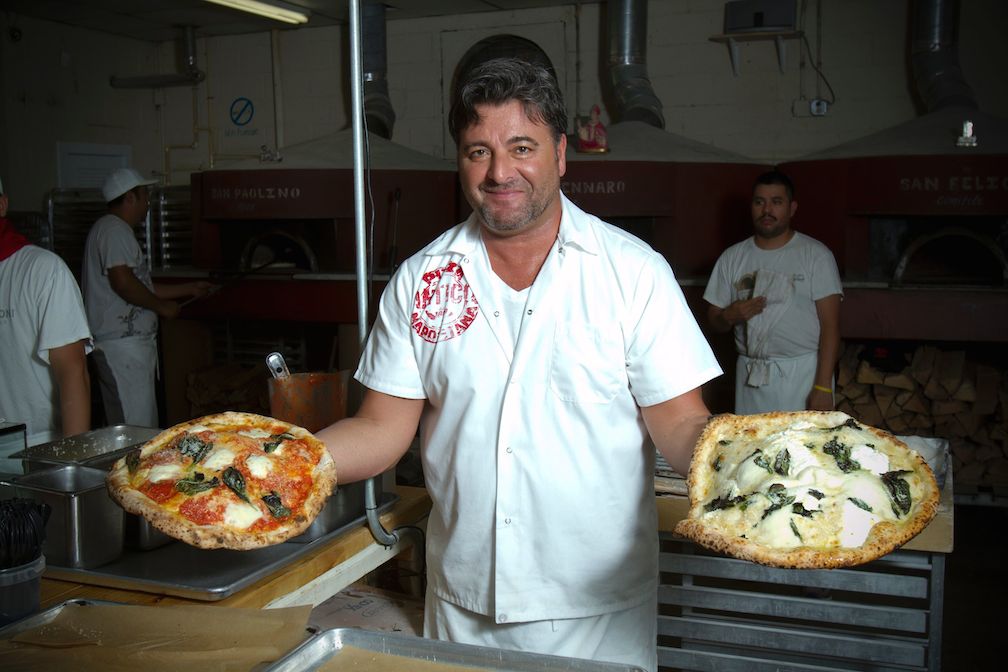 starting
off with a casual eatery that specializes in his
mother’s lemon chicken, adding a little Italian
sausage and cold cuts, more chicken dishes, and
basic maccheroni dishes with peperonicini
and tomato, marinara sauce with smoked scamorza
cheese, and a
few others. Don’t
be misled by the prices of full portions
here--$38-$43 for the chicken—for they are meant to
serve at least two people.
starting
off with a casual eatery that specializes in his
mother’s lemon chicken, adding a little Italian
sausage and cold cuts, more chicken dishes, and
basic maccheroni dishes with peperonicini
and tomato, marinara sauce with smoked scamorza
cheese, and a
few others. Don’t
be misled by the prices of full portions
here--$38-$43 for the chicken—for they are meant to
serve at least two people.
Across the way is his Pizza Antico Napoletana
(below)—a
madhouse of first-come-first serve, sit anywhere
communal tables, and it’s B.Y.O/B. (Bummer.) There’s a
list of ten pizzas—no slices!-- from $18-$22, only
produced “until the dough runs out.” At meal’s
end you an get cannoli or sfogliatelle
pastry. The place has had a lot of celebrity
sightings, including Chris Rock and Owen Wilson. Di
Palma himself, who contends he was once so poor he
slept in his Dodge Challenger, now drives to work in
an Aston Martin.
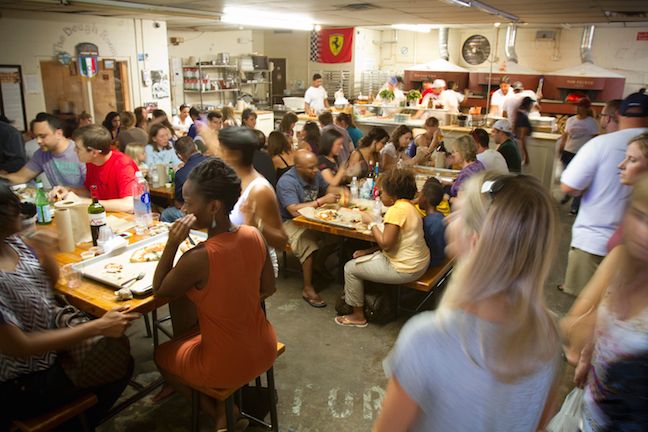 Other buildings
on the expanding property include a Bottega and a
Gelateria.
Other buildings
on the expanding property include a Bottega and a
Gelateria.
You can’t fault Di Palma’s exuberance and
good cheer, though local media seem to delight in
reporting on how he seems always to be getting in
and out of hot water in various dealings. They
include a contentiously embattled failed IT Company,
a messy public divorce, numerous lawsuits, and, a
few weeks ago, an investigation by the Federal
Department of Labor.
I
am certainly not in a position to offer any opinion
on that. Di Palma’s not the first entrepreneur
do go through such self-inflicted trials and
tribulations, so I hope they all shake out and he
can get back to doing what he loves—creating a Willy
Wonka-like Little Italy out in Westside.
Gio’s Chicken
Amalfitana is open for dinner Tues.-Sun; Pizza
Antico Mon.-Sat.
The Polaris Restaurant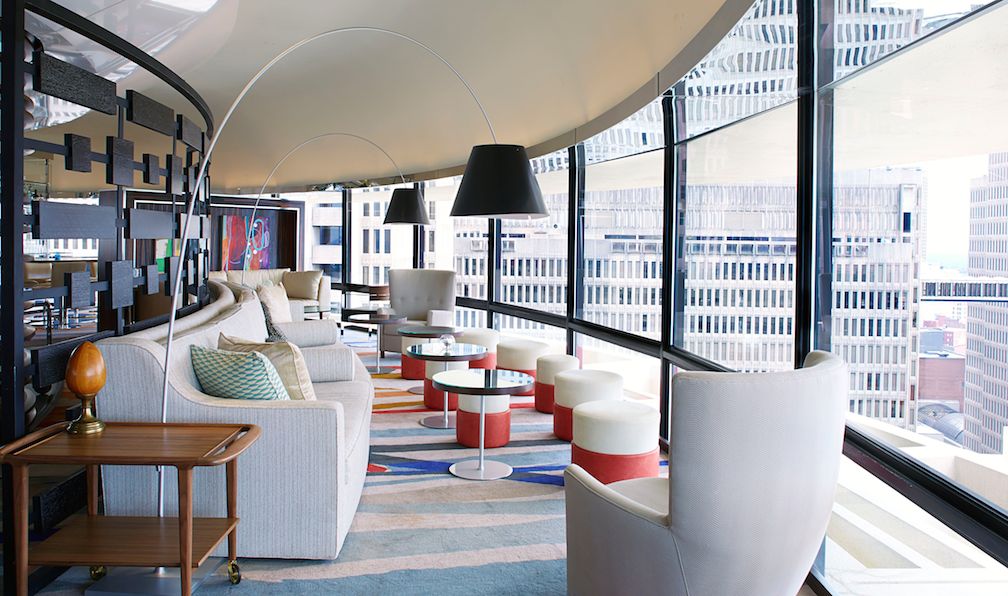
Hyatt Regency Atlanta
265 Peachtree Street, NE
404-460-6425
polarisatlanta.com
Photo by Laura Rubenstein
Back in the late 1960s the revolving
restaurant at the top of the Hyatt Regency was all
the rage, though more for the view than for the
food. It
lasted as a tourist attraction for decades but
finally shut down.
Now, having undergone a total renovation by
Johnson Studios, it is called the Polaris
Restaurant, re-opened this past June.
It features small plates at a variety of perches on
the 45-minute rotating platform that gives you a
360-degree view of Atlanta’s skyline, which only
recently has acquired any architecture that’s
interesting to look at. Most of downtown looks like it
was built by the Veteran’s Administration.
The dining "zone" at Polaris features a custom
walnut communal table; the library and living room
have lounge seating and sectional sofas and screens;
the bar is where a good deal of the nightly action
takes place, especially at sundown. Throughout
there is a lot of bold modern artwork and sculpture,
and the ceiling is finished with a remarkable,
unnoticeable polished material that sucks up noise.
More
restaurateurs should find out about this.
I hadn’t the time to dine at The Polaris, but I
found the place a pleasant diversion in the
otherwise dreary downtown. And after
all these years, it’s still fun to zoom up the
atrium in those original John Portman elevators.
❖❖❖
By John Mariani
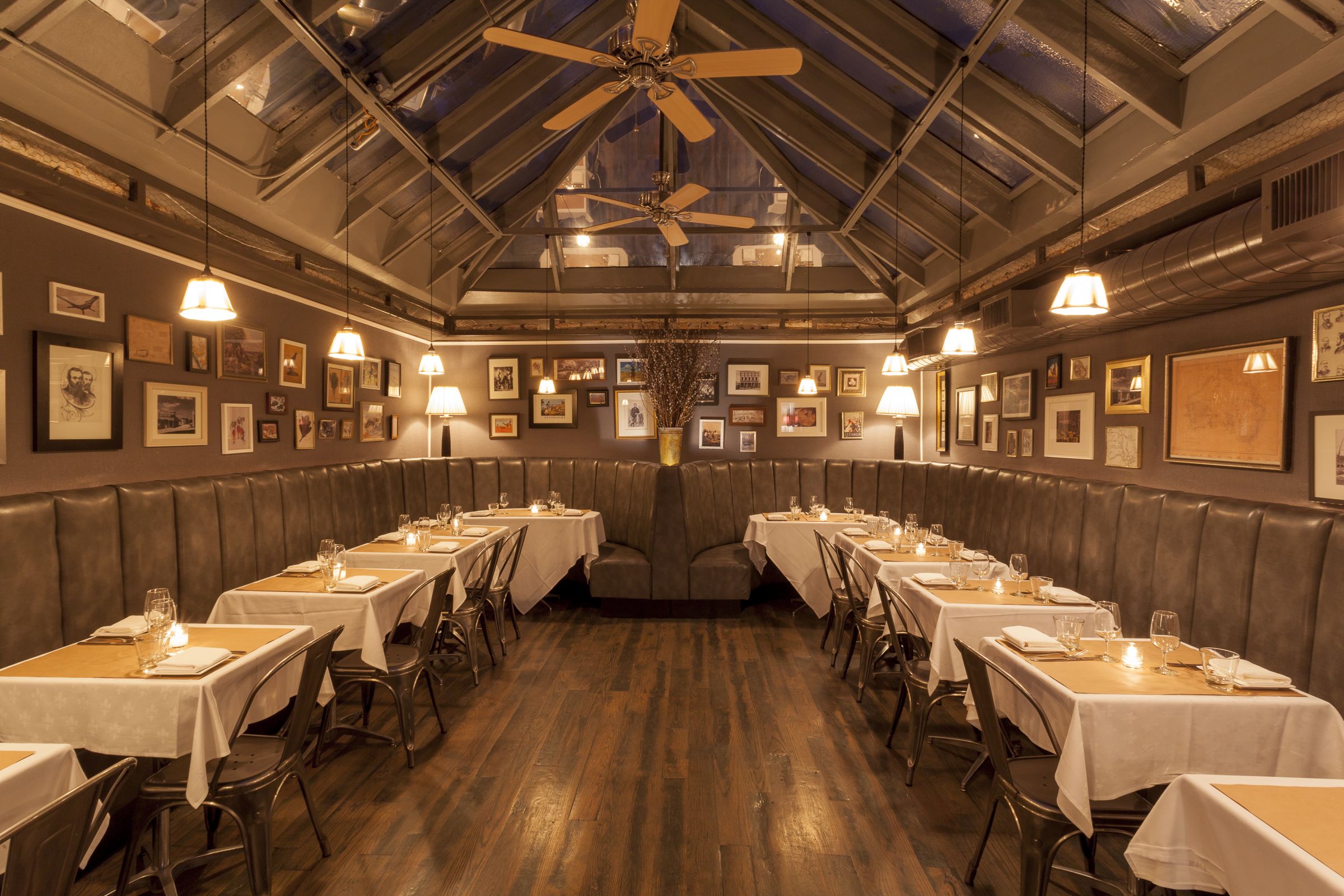 BURKE &WILLS
BURKE &WILLS
226 West 79th Street
646-823-9251
burkeandwillsny.com
The
cuisine of Australia has not exactly captivated
the rest of the world, but then, it’s not an
easy cuisine to pin down. According
to Alan Davidson’s Oxford
Companion to Food, Australia is rich in
flora, with 25,000 plant species, more than
Europe, though it has only two percent of the
world’s freshwater fish species.
Its aboriginal people’s diet was very
basic, so, with colonization by the British, the
continent’s gastronomy developed along British
culinary traditions—shepherd’s pie, steamed
puddings and the like. But, over the past twenty
years Australia’s urban chefs have shown as much
imagination and culinary talent as any on Earth. Most
revel in their indigenous provender, while readily
absorbing the cuisines of the Pacific Rim into
their kitchens.
Australian cuisine, not unlike American, is
then an amalgam immigrant cuisine, and, while New
York has had a few restaurants open under the
Australian banner, the year-old Burke & Wills
on the Upper West Side makes a fine showing.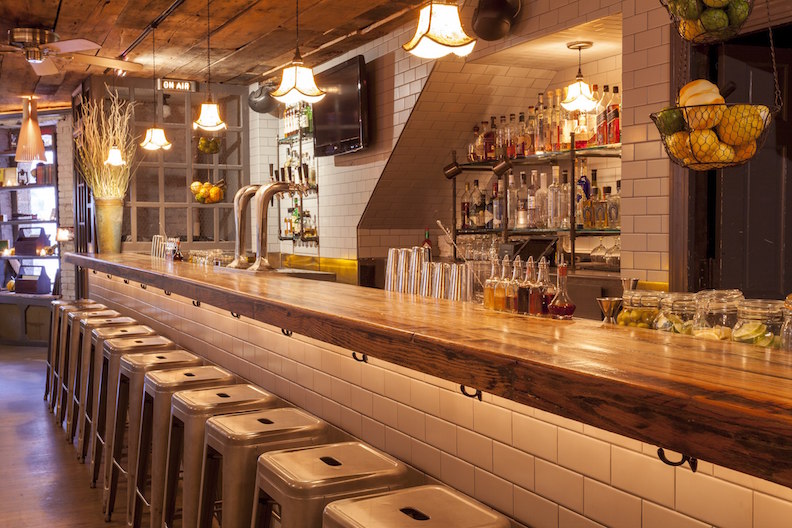
Named for pioneering adventurers who made
an expedition across Australia in 1860, Burke
& Wills is Tim Harris and Matilda Boland’s
homage to the land Down Under. Harris grew up in
the restaurant business in Australia, and
previously worked at another Aussie restaurant
(now closed) named Bondi Road. Now, with Executive Chef Rodrigo Nogueira
(previously at Montmartre and the Monkey Bar), he has
created a menu that offers a savory introduction
to the kind of modern cuisine being served in
Sydney, Melbourne and other cities, with an
emphasis on the rotisserie. Harris
is also your ebullient guide through a wine list
heavily stocked with some of the best Aussie and
New Zealand bottlings available in NYC.
Up front is a long, polished bar offering
raw shellfish and a small plates menu of items
like beef tartare with smoked egg and capers, and
a crispy crab beignet with Japanese mayo and
bonito flakes.
The very cozy dining room to the rear, with
an angled skylight ceiling, is done in handsome
shades of slate gray
banquettes, white tablecloths and distressed
stained wood, with antique Australian photos and
maps on the walls. Our amiable waitress was
herself appropriately an Aussie and was very
helpful in explaining the menu and anything else
I asked her about the cooking and Australia in
general.
The
menu is of a sensible size (the kitchen is
cramped), with eight first courses, six mains, one
or two specials, and five desserts. Our
table began with fine tuna sashimi with a lush
lemon
custard and contrasting smoked hon shimeji
mushrooms ($16).
Foie gras torchon
($17) was made less predictable with the addition
of a sea scallop, a confit of apple, a drizzle of
honey and brioche bread. Sweet bay scallops were a
special that evening, gently sautéed and subtly
seasoned, tender and juicy, in a ginger broth.
Best of all the starters was a highly flavorful,
very juicy crêpinette of lamb with roasted
cauliflower, capers and a lamb jus
($15).
B&W’s “large plates” live up to their
boast: portions are very generous, and prices are,
too, $17-$29.
Even if unexpected in an Aussie bistro,
potato gnocchi with roasted mushrooms, pecorino
and grilled scallions were very welcome at our
table, as was roasted chicken with roasted baby
patty pan squash and a rich brown butter sauce.
The fish that night was barramundi, which was pan
seared and quite succulent, and the accompanying
fennel barigoule
and pickled fennel gave it tart spiking. (For the
ichthyologists out there, this barramundi is an
Asian sea bass, farmed in the U.S., not the
barramundi cod that swims in Australian waters.)
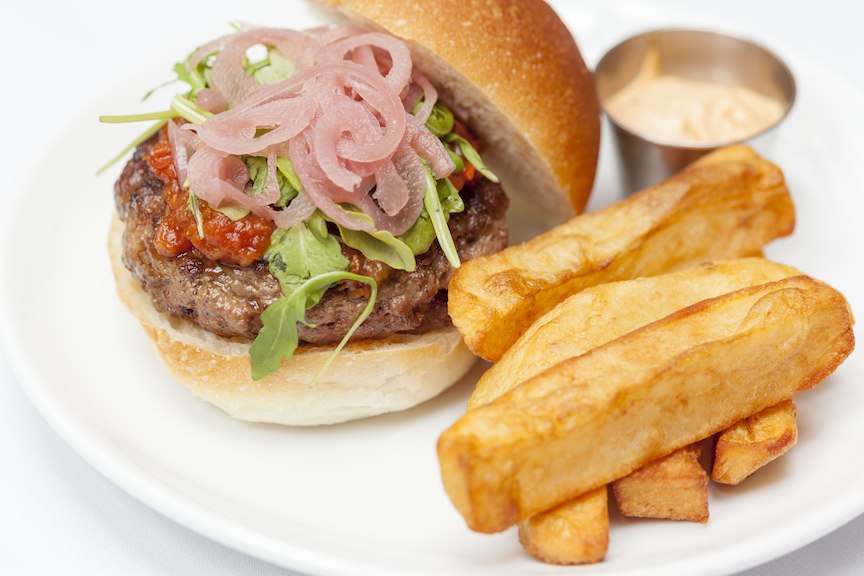 Of
course, what’s an Australian menu without
kangaroo? At
B&W the marsupial shows up as an appetizer of
loin with onion soubise,
roasted mushrooms and fingerling potatoes, and as
a “’roo burger,” which is big and hearty, on a
good roll, with tomato jam, shaved onions and fat,
triple-fried potatoes (which they call “chips”). It’s a
good dish, not very fatty, though more a curiosity
when compared to a more flavorful beef burger. Oddly,
the dish lacked a fried egg, traditional to
Australian burgers.
Of
course, what’s an Australian menu without
kangaroo? At
B&W the marsupial shows up as an appetizer of
loin with onion soubise,
roasted mushrooms and fingerling potatoes, and as
a “’roo burger,” which is big and hearty, on a
good roll, with tomato jam, shaved onions and fat,
triple-fried potatoes (which they call “chips”). It’s a
good dish, not very fatty, though more a curiosity
when compared to a more flavorful beef burger. Oddly,
the dish lacked a fried egg, traditional to
Australian burgers.
Best of the
main courses was a spiced duck breast, meaty, well
fatted and served with farrotto, roasted
turnips, and honey turnip puree.
You shouldn’t skip dessert here (all $8).
At least share the warm chocolate cake with orange
syrup, and amaretto crunch gelato,
or the Pavlova--the one Australian dish many people
will recognize—named after Russian ballet dancer
Anna Pavlova, who did several tours of Australia
and New Zealand. It is a meringue torte with
passion fruit curd, berries and kiwi fruit and
then lavished with whipped cream.
Upstairs at
B&W is a wood-paneled cocktail lounge—they
call it a “private speakeasy open to the
public”—named The Manhattan Cricket Club, arrayed
with Australian cricket paraphernalia and
photographs of turn-of-the-century players.
In
the end, you may not exit B&W with a thorough
understanding of Aussie cuisine, but you will have
eaten well in a casual but sophisticated ambiance
you won’t easily find downtown. Anyone
who lives on the Upper West Side may well make it
their own personal club to frequent.
Burke & Wills is located at 226 W 79th
Street, 646-823-9251,
www.burkeandwillsny.com and is open seven days a
week for cocktails, bar snacks, dinner, late
night and weekend brunch.
❖❖❖
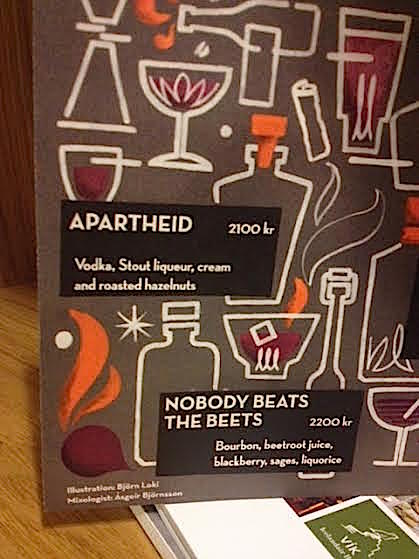 DEPT. OF BAD TASTE IN THE MOUTH
DEPT. OF BAD TASTE IN THE MOUTH
The Hotel Reykjavík Marina in Iceland named a cocktail
the "Apartheid" in its drinks menu,
containing vodka, stout liqueur, cream, and hazelnuts.
The hotel later apologized and removed it.
GEE! WE NEVER WOULD HAVE THOUGHT OF

ANY OF THESE ALL ON OUR OWN!!!
El Celler de Can Roca,
Girona : "Even if you encounter the same bleak
e-fate we did, you can also try calling or e-mailing the
restaurant to get yourself on the wait list."
Tickets, Barcelona:
"Stop by when you’re in town and check with the emcee to
see if any last-minute cancellations have freed up a
table."
Sukiyabashi, Tokyo:
"To get a seat at the ten-person bar, you'll need to
know a Tokyo native (or have other Japanese host who can
vouch for you) and that's with the help of a hotel
concierge to boot."
Schwa,
Chicago: "Patience, grasshopper—that and
flexibility."
 I'm proud and happy to
announce that my new book, The Hound in Heaven
(21st Century Lion Books), has just been published
through Amazon and Kindle. It is a Christmas
novella, and for anyone who loves dogs, Christmas,
romance, inspiration, even the supernatural, I hope
you'll find this to be a treasured favorite. The
story concerns how, after a New England teacher, his
wife and their two daughters adopt a stray puppy found
in their barn in northern Maine, their lives seem full
of promise. But when tragedy strikes, their wonderful
dog Lazarus and the spirit of Christmas are the only
things that may bring back his master back from the
edge of despair.
I'm proud and happy to
announce that my new book, The Hound in Heaven
(21st Century Lion Books), has just been published
through Amazon and Kindle. It is a Christmas
novella, and for anyone who loves dogs, Christmas,
romance, inspiration, even the supernatural, I hope
you'll find this to be a treasured favorite. The
story concerns how, after a New England teacher, his
wife and their two daughters adopt a stray puppy found
in their barn in northern Maine, their lives seem full
of promise. But when tragedy strikes, their wonderful
dog Lazarus and the spirit of Christmas are the only
things that may bring back his master back from the
edge of despair. WATCH
THE VIDEO
“What a huge surprise turn this story took! I was
completely stunned! I truly enjoyed this book and its
message.” – Actress Ali MacGraw
“He had me at Page One. The amount of heart, human
insight, soul searching, and deft literary strength that
John Mariani pours into this airtight novella is
vertigo-inducing. Perhaps ‘wow’ would be the best
comment.” – James Dalessandro, author of Bohemian Heart
and 1906.
“John Mariani’s Hound
in Heaven starts with a well-painted portrayal
of an American family, along with the requisite dog. A
surprise event flips the action of the novel and
captures us for a voyage leading to a hopeful and
heart-warming message. A page turning, one sitting read,
it’s the perfect antidote for the winter and promotion
of holiday celebration.” – Ann Pearlman, author of The Christmas Cookie Club
and A Gift for my
Sister.
“John Mariani’s concise, achingly beautiful novella
pulls a literary rabbit out of a hat – a mash-up of the
cosmic and the intimate, the tragic and the
heart-warming – a Christmas tale for all ages, and all
faiths. Read it to your children, read it to yourself…
but read it. Early and often. Highly recommended.” – Jay
Bonansinga, New York
Times bestselling author of Pinkerton’s War, The
Sinking of The Eastland, and The Walking Dead: The Road
To Woodbury.
“Amazing things happen when you open your heart to an
animal. The Hound in
Heaven delivers a powerful story of healing
that is forged in the spiritual relationship between a
man and his best friend. The book brings a message of
hope that can enri
Any of John Mariani's
books below may be ordered from amazon.com.
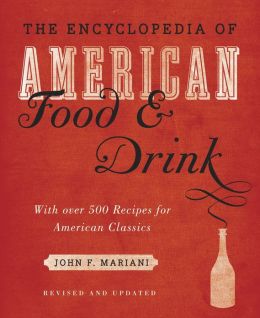 |
The Encyclopedia of American Food and Drink by John F. Mariani (Bloomsbury USA, $35) Modesty forbids me to praise my own new book, but let me proudly say that it is an extensive revision of the 4th edition that appeared more than a decade ago, before locavores, molecular cuisine, modernist cuisine, the Food Network and so much more, now included. Word origins have been completely updated, as have per capita consumption and production stats. Most important, for the first time since publication in the 1980s, the book includes more than 100 biographies of Americans who have changed the way we cook, eat and drink -- from Fannie Farmer and Julia Child to Robert Mondavi and Thomas Keller. "This book is amazing! It has entries for everything from `abalone' to `zwieback,' plus more than 500 recipes for classic American dishes and drinks."--Devra First, The Boston Globe. "Much needed in any kitchen library."--Bon Appetit. |
"Eating Italian will
never be the same after reading
John Mariani's entertaining and
savory gastronomical history of
the cuisine of Italy and how it
won over appetites worldwide. . .
. This book is such a tasteful
narrative that it will literally
make you hungry for Italian food
and arouse your appetite for
gastronomical history."--Don
Oldenburg, USA Today. "Italian
restaurants--some good, some glitzy--far
outnumber their French rivals. Many of
these establishments are zestfully described
in How Italian Food Conquered the World, an
entertaining and fact-filled chronicle by
food-and-wine correspondent John F.
Mariani."--Aram Bakshian Jr., Wall Street
Journal.
"Equal parts
history, sociology, gastronomy, and just
plain fun, How Italian Food Conquered the
World tells the captivating and delicious
story of the (let's face it) everybody's
favorite cuisine with clarity, verve and
more than one surprise."--Colman Andrews,
editorial director of The Daily
Meal.com. "A fantastic and fascinating
read, covering everything from the influence
of Venice's spice trade to the impact of
Italian immigrants in America and the
evolution of alta cucina. This book will
serve as a terrific resource to anyone
interested in the real story of Italian
food."--Mary Ann Esposito, host of PBS-TV's
Ciao
Italia. "John Mariani has written the
definitive history of how Italians won their
way into our hearts, minds, and
stomachs. It's a story of pleasure over
pomp and taste over technique."--Danny Meyer,
owner of NYC restaurants Union Square
Cafe, The Modern, and Maialino.
|
 |
 |
 |
 |
 |
 |
 |
 |
 Everett Potter's
Travel Report:
Everett Potter's
Travel Report: I consider this the best and savviest blog of its kind on the web. Potter is a columnist for USA Weekend, Diversion, Laptop and Luxury Spa Finder, a contributing editor for Ski and a frequent contributor to National Geographic Traveler, ForbesTraveler.com and Elle Decor. "I’ve designed this site is for people who take their travel seriously," says Potter. "For travelers who want to learn about special places but don’t necessarily want to pay through the nose for the privilege of staying there. Because at the end of the day, it’s not so much about five-star places as five-star experiences."

 Eating Las Vegas
is the new on-line site for Virtual Gourmet
contributor John A. Curtas., who since 1995
has been commenting on the Las Vegas food
scene and reviewing restaurants for Nevada
Public Radio. He is also the
restaurant critic for KLAS TV, Channel 8 in
Las Vegas, and his past reviews can be
accessed at KNPR.org.
Click on the logo below to go directly to
his site.
Eating Las Vegas
is the new on-line site for Virtual Gourmet
contributor John A. Curtas., who since 1995
has been commenting on the Las Vegas food
scene and reviewing restaurants for Nevada
Public Radio. He is also the
restaurant critic for KLAS TV, Channel 8 in
Las Vegas, and his past reviews can be
accessed at KNPR.org.
Click on the logo below to go directly to
his site.

MARIANI'S VIRTUAL GOURMET
NEWSLETTER is published weekly. Editor/Publisher: John
Mariani.
Editor: Walter Bagley. Contributing Writers: Christopher Mariani,
Robert Mariani, Misha
Mariani,
John A. Curtas, Edward Brivio, Mort Hochstein,
Andrew Chalk, Dotty Griffith and Brian Freedman. Contributing
Photographers: Galina Dargery, Bobby
Pirillo. Technical Advisor: Gerry McLoughlin.
To un-subscribe from this newsletter,click here.
© copyright John Mariani 2014
